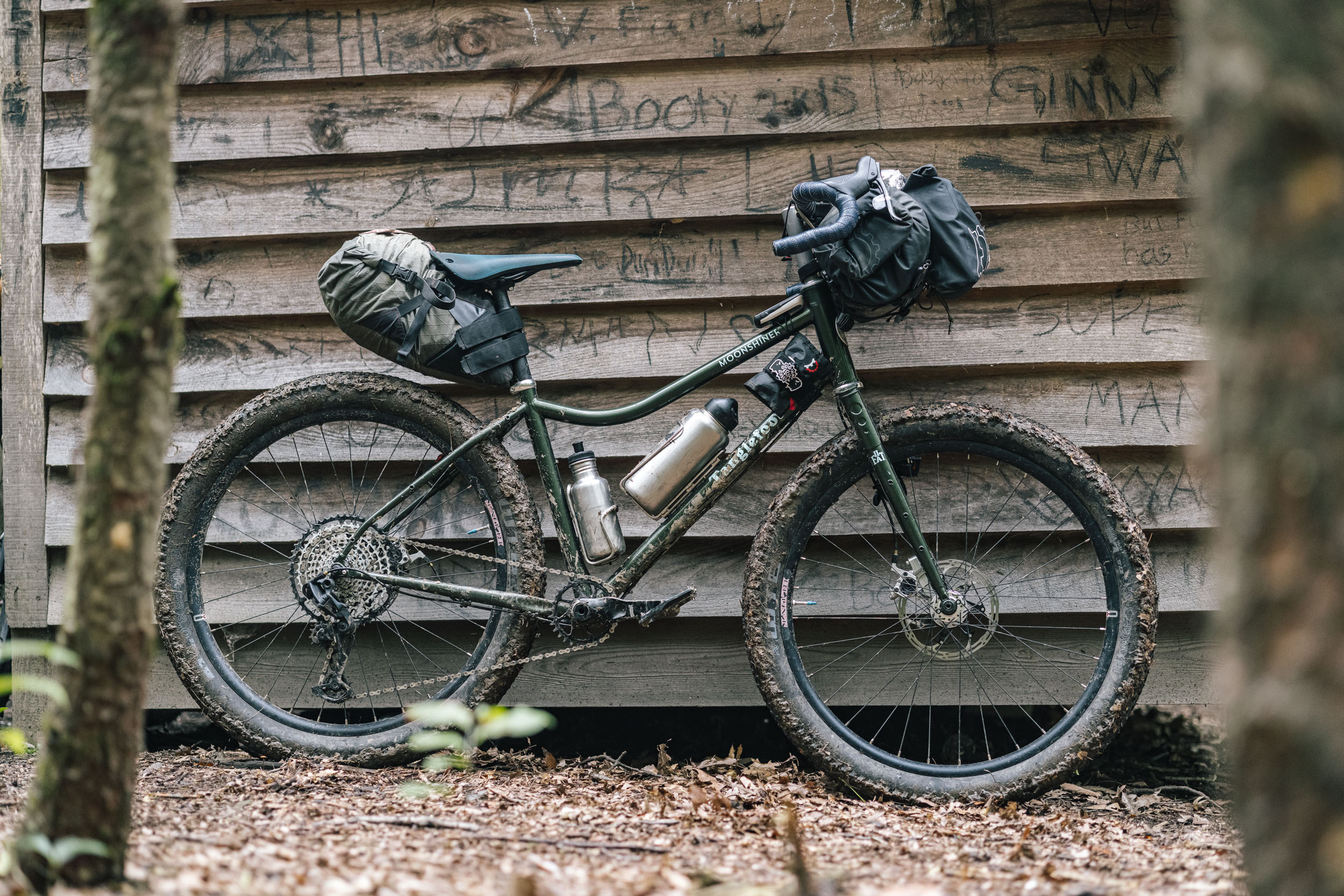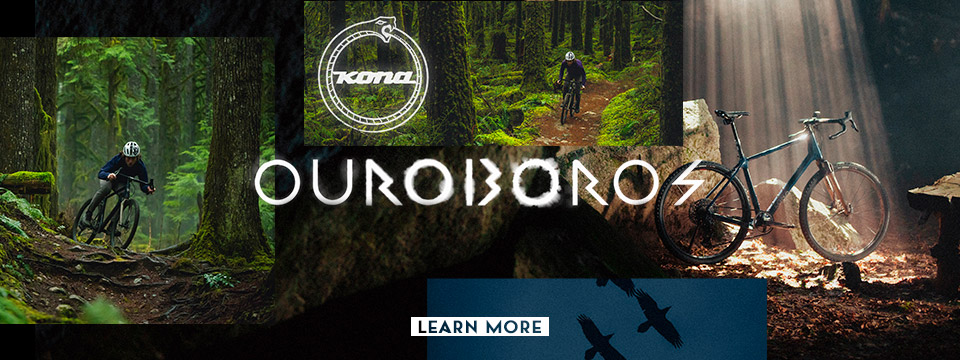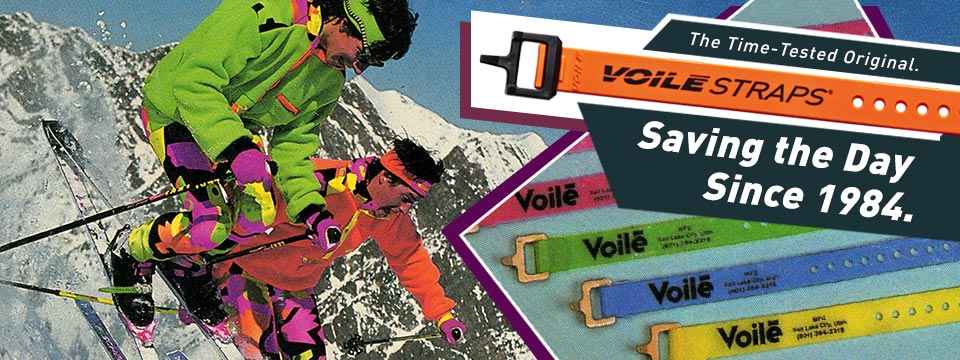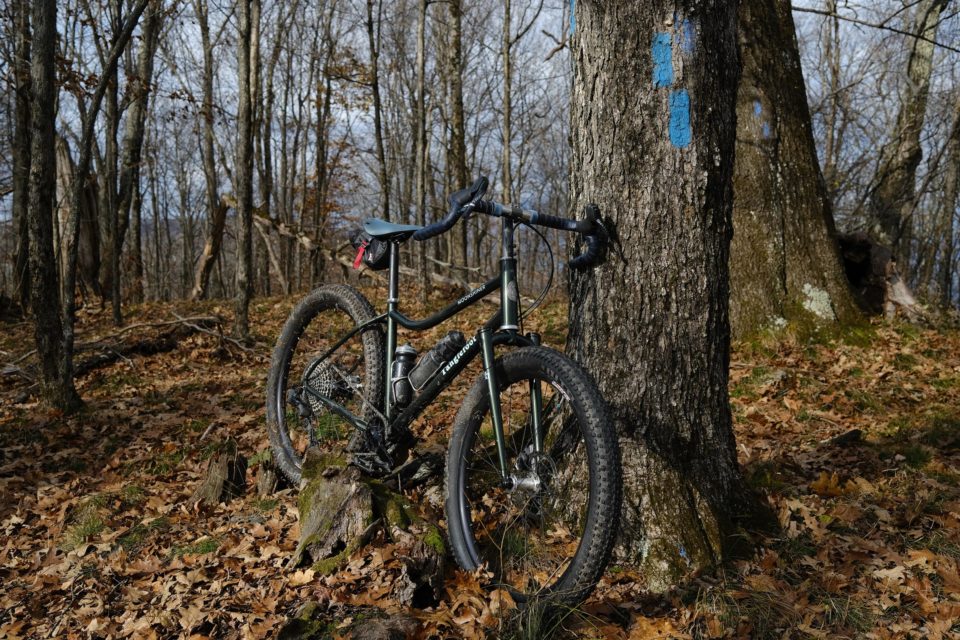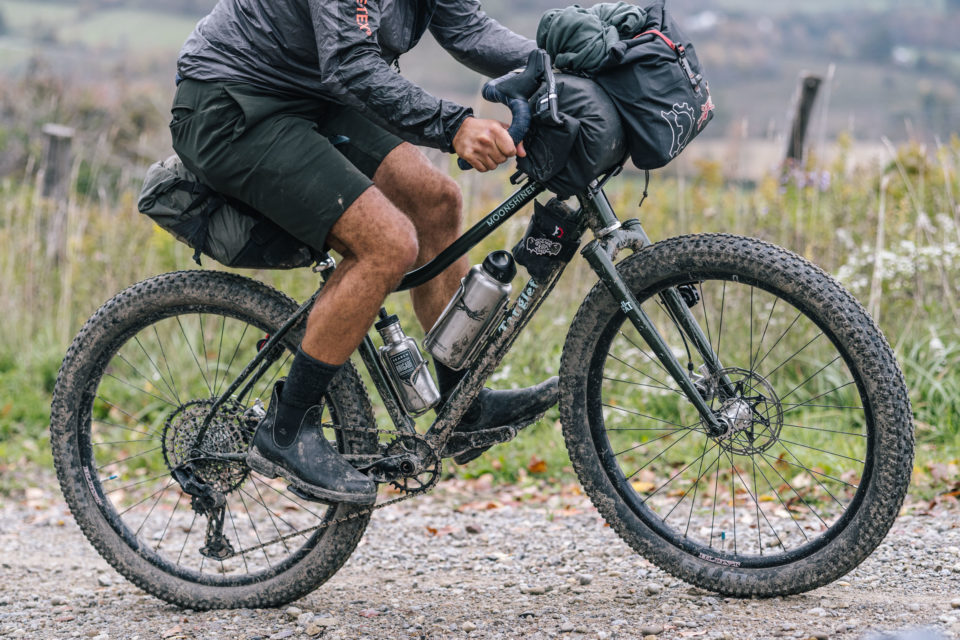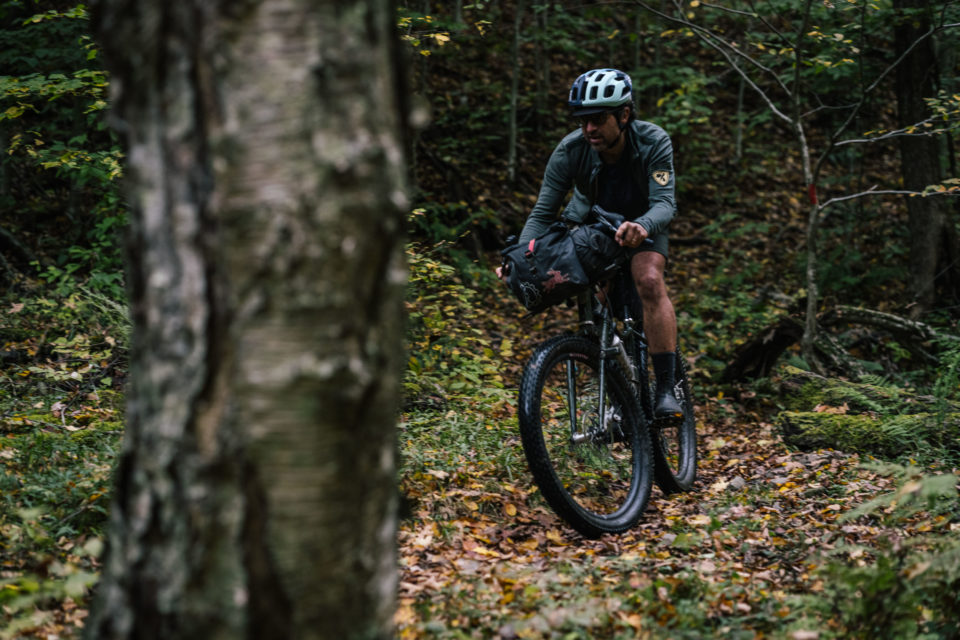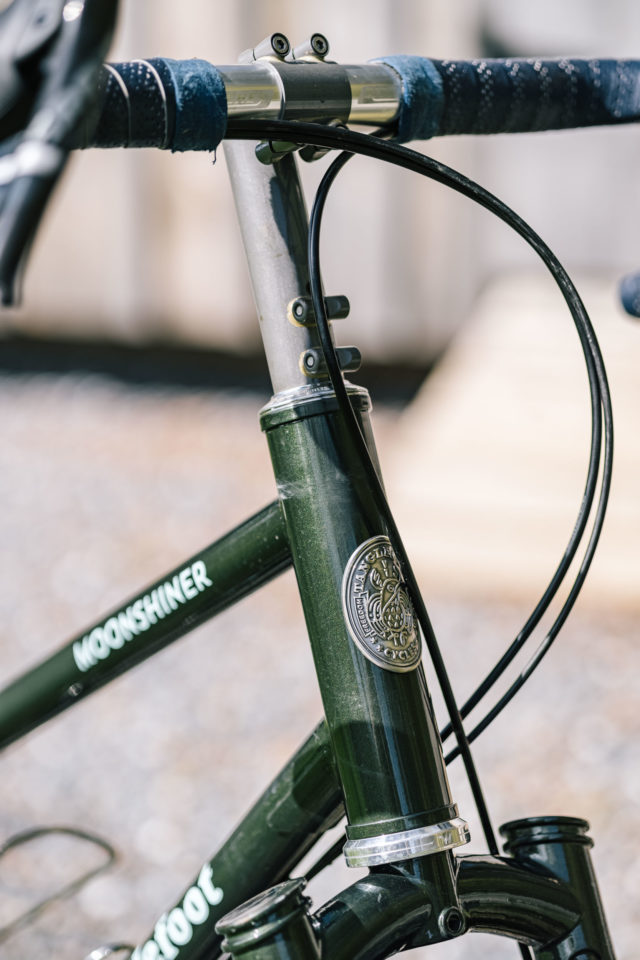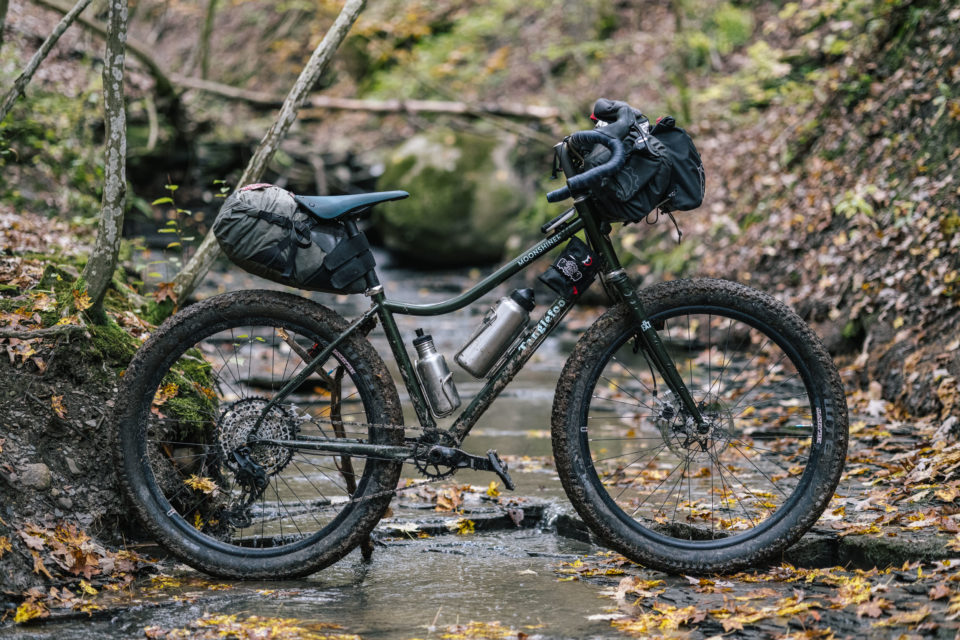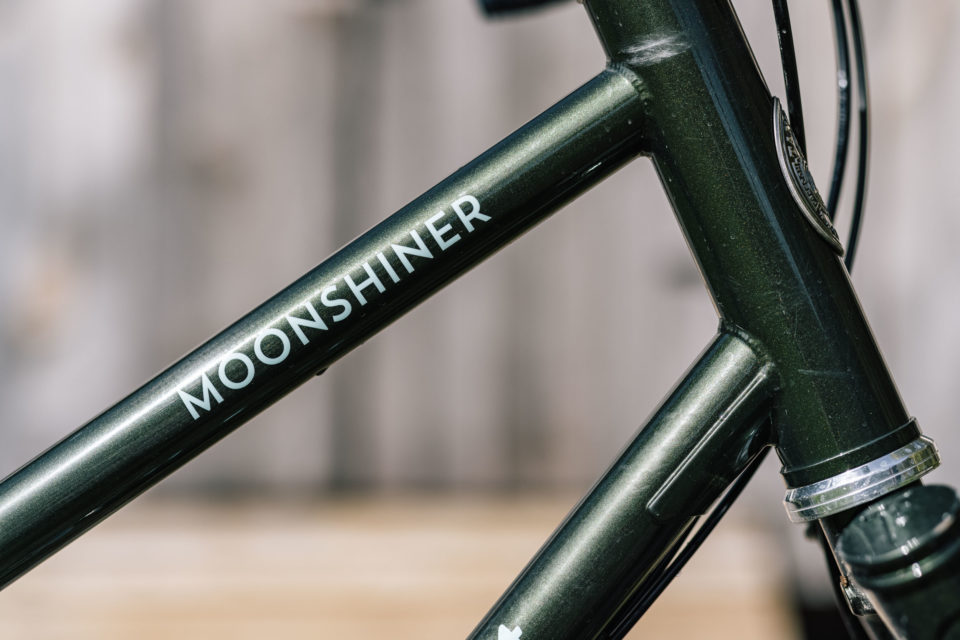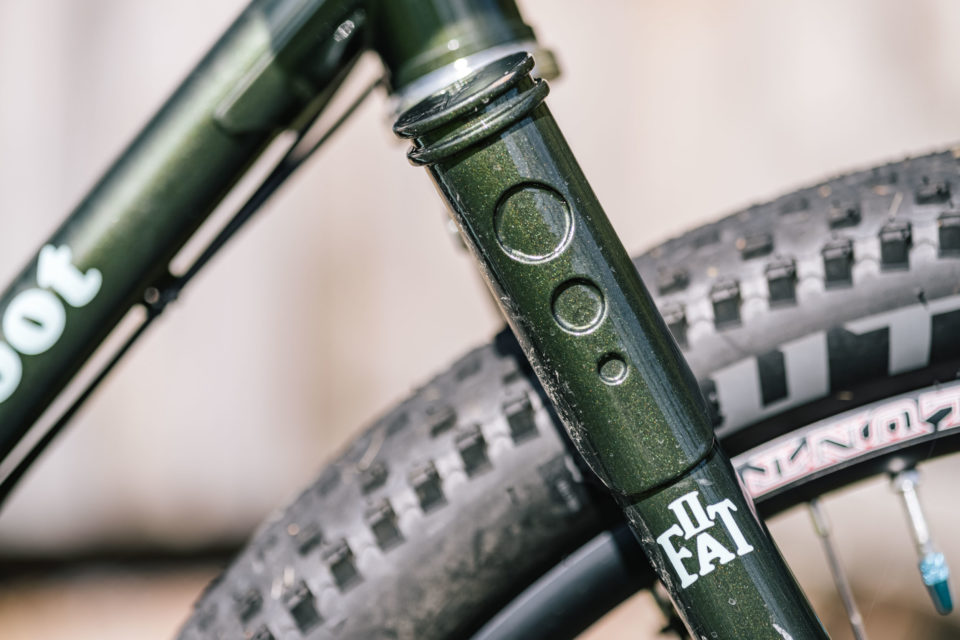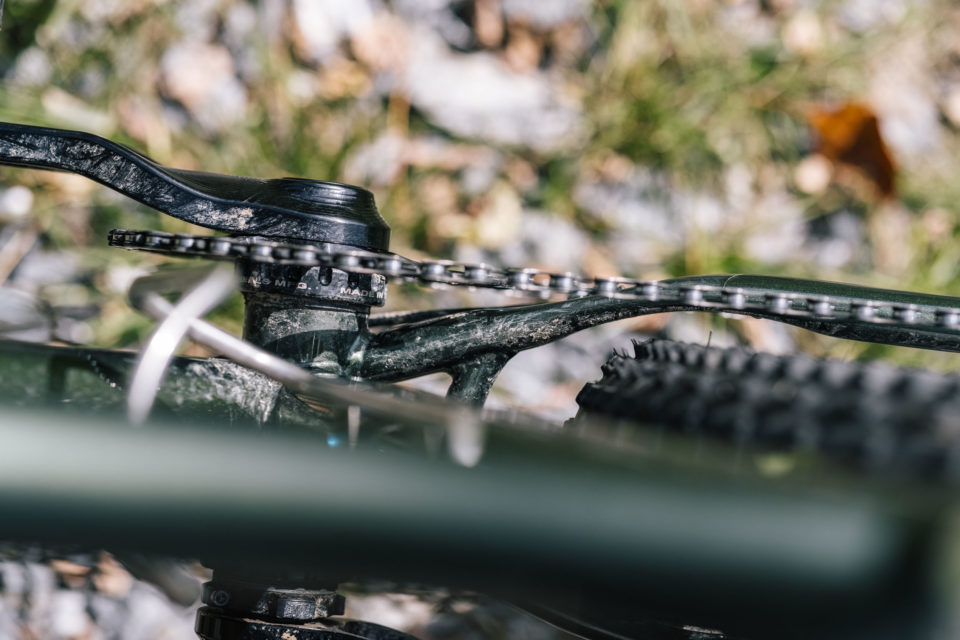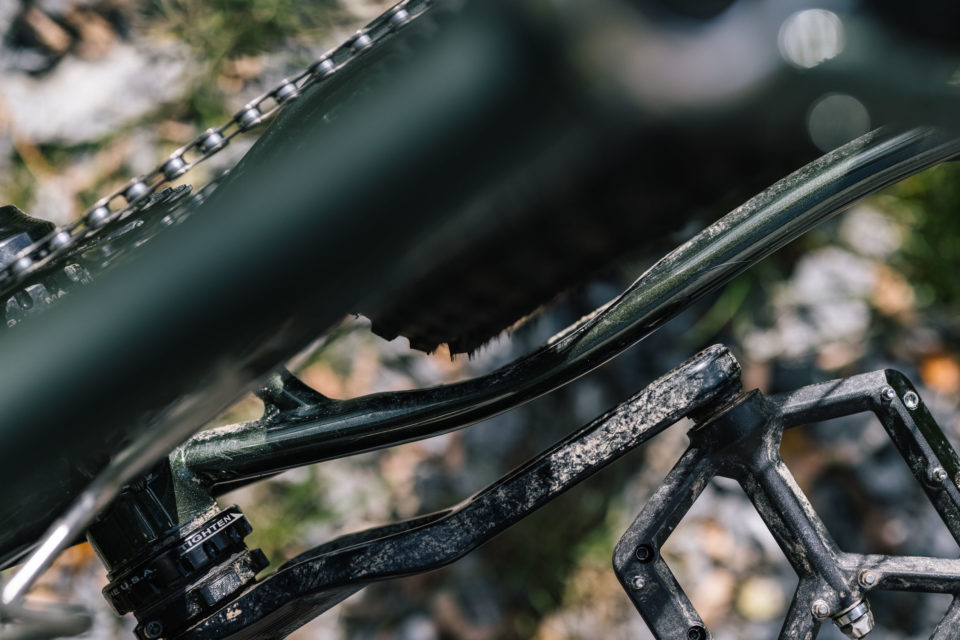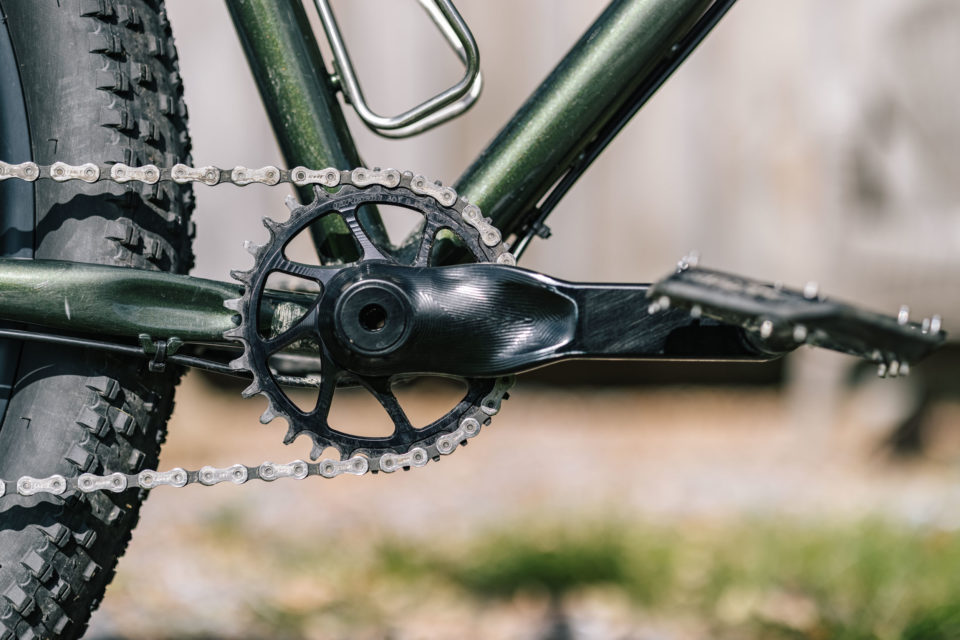Tanglefoot Moonshiner Review: Triumphal Pedaling Toward Retro-Futurism
The Tanglefoot Moonshiner is a woods exploration bike conceived in and for the kind of riding you’ll find in Vermont and throughout New England. But its prowess doesn’t end there. It’s a bike for getting outside in the playful adventurous spirit that all-terrain bikes were supposed to be for. Dig in to this lengthy discussion to find out why—after riding one in a variety of conditions for a couple of months—Joe is excited and enthusiastic for what Tanglefoot has achieved.
PUBLISHED Dec 9, 2021
Photos by Logan Watts and Joe Cruz
If I only ever merely looked at it, I might have remained of the opinion that the Tanglefoot Moonshiner isn’t my jam. That would have been a lamentable assumption and loss on my part. After riding it for a couple months, I can say that it is one of the best handling, most capable, fun, and forward-thinking woods exploration bikes I’ve ever been on. Those superlatives come, of course, with a range of caveats and elaborations that I’ll visit below. But anyone wondering what my overall impression is, it’s that I think the Moonshiner is flat-out superb.
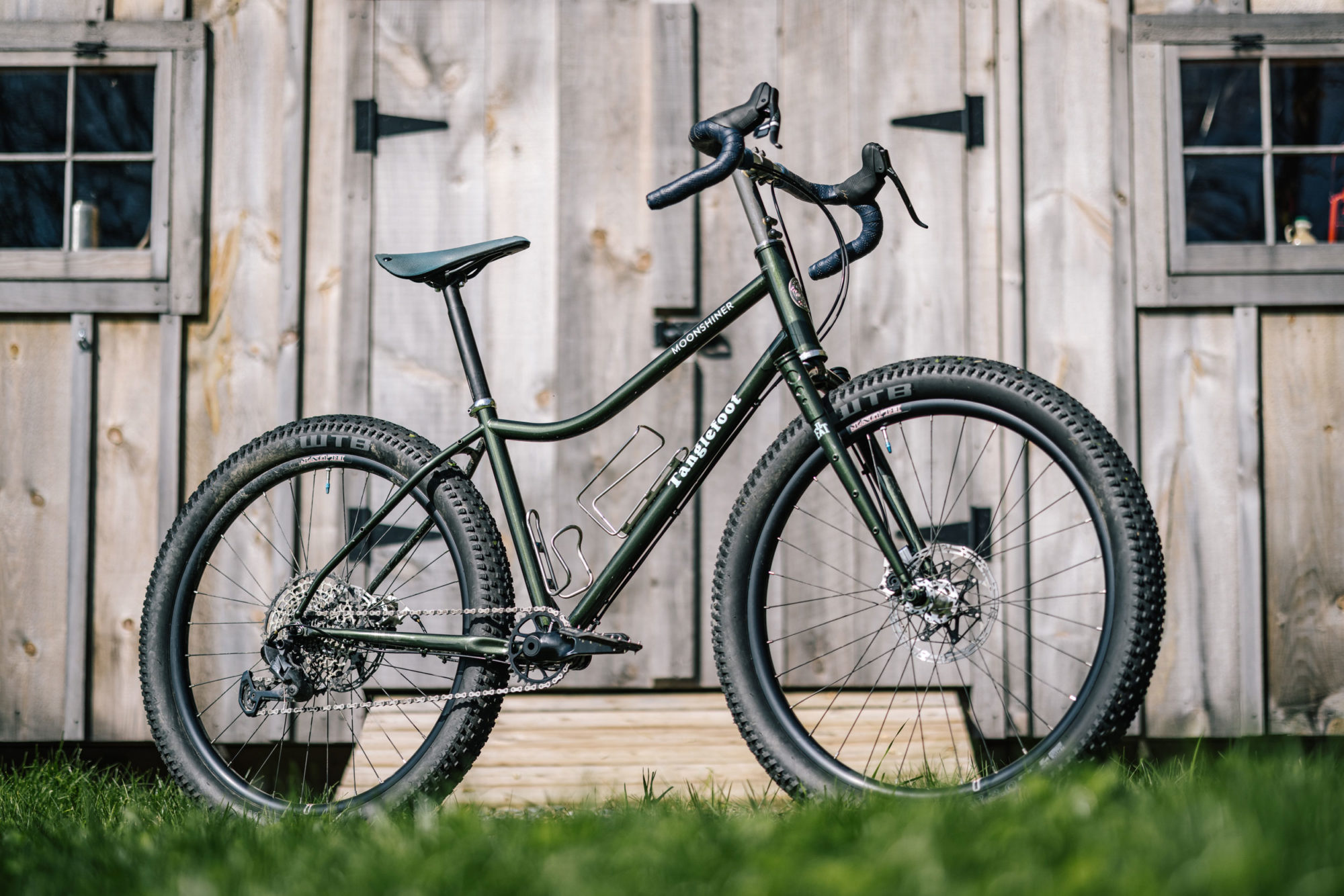
At home, the kind of riding that I do most frequently and that gives me the most joy is traditional New England forest traversing. It is heading into the woods on an abandoned road that is often hardly more than a hint of a doubletrack punctuated by hub-deep mud, rooty go-arounds, and treefall that you can barely loft the front wheel over. There is a fair share of winding singletrack, but again with an old-timey vibe: a rocky, slippery, poorly cambered narrow path where low-speed balance, fluttering the front wheel through gaps, and maneuvering around rutted switchbacks is paramount. It’s scaling hundred-year-old stone walls, finding a long-abandoned orchard or cemetery, and bucking down steep loose babyhead chutes that funnel into a creek splashthrough. It’s the sort of ride where you pedal all day averaging barely 10km/hour, but all of it is a feeling of being embraced by the sylvan landscape.
The Moonshiner was imagined for precisely this kind of ride. It is a steel bike with clearance for 27.5 x 3.0” tires on 35mm rims. It has a 69 degree head tube angle, a slack 71 degree seat tube angle, and a high bottom bracket (51mm of drop). All those numbers are preserved across the three sizes. It’s intended to be built up with a high-stack, 0mm or 30mm stem for riding in the hooks basically all of the time. The trail is also high at 88.7mm in all sizes. The top tube bend provides ample standover height.
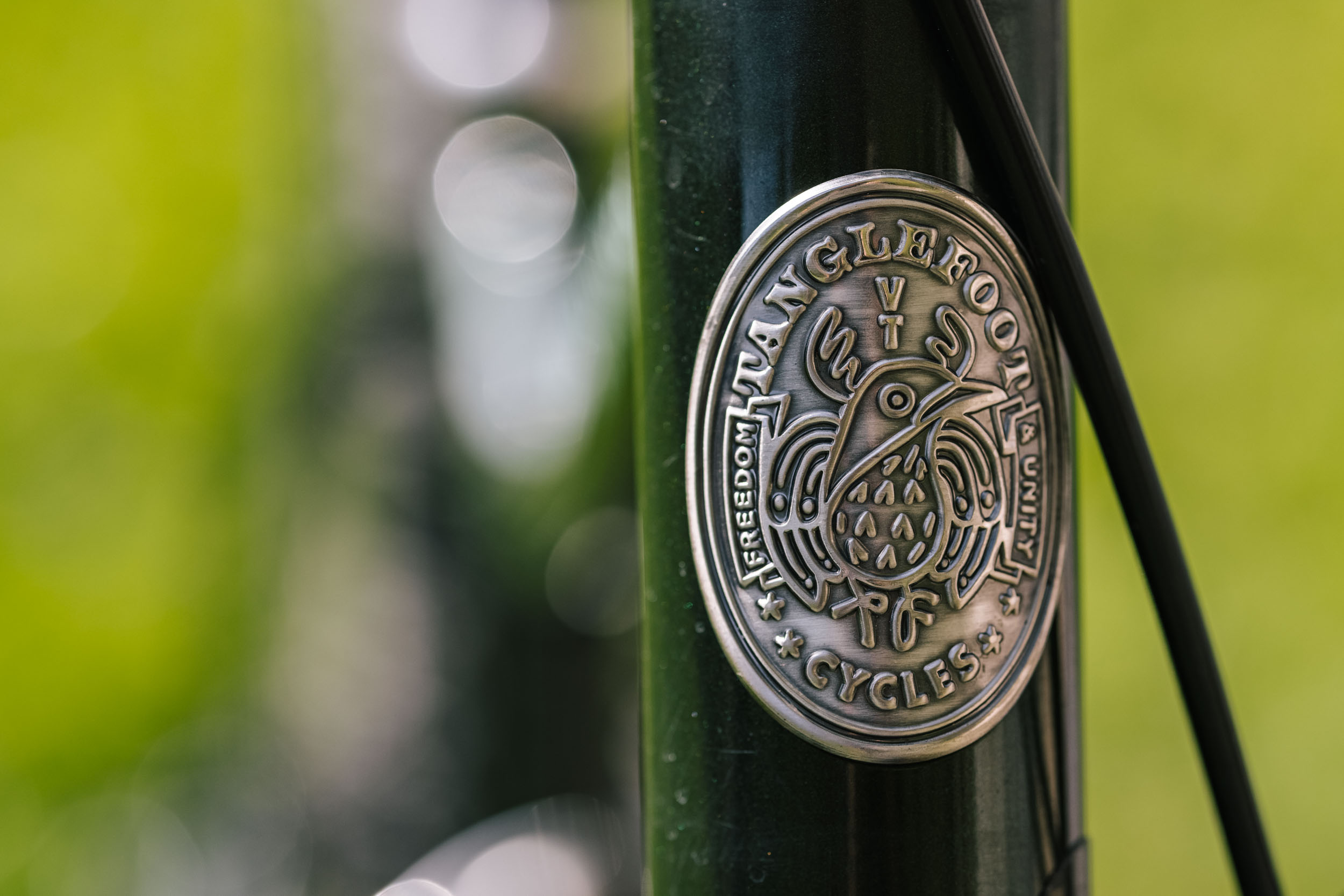
The Moonshiner is the product of the mind of cycling industry veteran and cognoscente James Johnson. James has been a mechanic and bike fitter, and, in addition to designing and selling products that express his philosophies, these days he co-owns Analog Cycles with Candice Passehl. Tanglefoot Cycles is their bike brand. Tanglefoot is in equal measures quirky and serious. Really, check out their website. You’ll find interesting, thoughtful, and funny stuff including musings about the limitations of conceptual painter Frank Stella and the insights of jazz pianist Bill Evans. James observes, “We are awash in the lurid excess of the new. Culture produces without knowing the reason for production. The headlong rush for the new ignores lessons learned in the past, leading to repeated failures and waste.” That’s where the retro-futurism of the title of this review comes from. James sets out these ideas in a manifesto that is for me in turn wise, hilarious, and liberating even if I don’t always agree with it.
James worked for five years to bring the Moonshiner to production. He has a clear idea of how he wants a bicycle to ride. As he says, a bike should achieve “comfort, longevity, a calm and planted feeling, and sturdiness.” These aren’t particularly compelling marketing terms, but they are at the center of the vision for Tanglefoot. Folks like Grant Peterson have been saying similar things for a couple of decades, and James names Peterson as an inspiration.
Don’t think about the Moonshiner as a gravel bike with clearance for big tires and a high drop bar. Those bikes often still have road or randonneur DNA, not that there’s anything wrong with that if that’s what you’re looking for. The Moonshiner is an ATB in a sense that it seems to me we’ve largely lost touch with: not focused on speed or adrenaline, but certainly not limited to dirt roads or “easy” singletrack, either. It’s an inheritor of early Charlie Cunningham or Steve Potts dirt drop designs that are a delight to marvel at, and also (according to James) includes insight from the Wright brothers, the bikes Eddy Merckx won races on in the 1970s, Chris Chance’s bikes, the Crust Evasion, and the Surly ECR. The Moonshiner is the result of trying to synthesize all of these into a single vision, improve on each where improvement is possible, and to do it with reliable contemporary technology.
OKAY, BUT HOW DOES IT RIDE?
The Moonshiner is proposed as a solution to the multidimensional equation of comfort, control, all-day woods riding, and bombproofness. In my judgment, it absolutely succeeds.
It is a joy to be on. It made me want to keep riding and never worry that there was someplace I couldn’t pedal it. More clinically, it is stable and balanced for very precise turns at all speeds. There’s a real sense of being right between the wheels. It yields notable confidence in picking through obstacles and it’s frankly nuts how placid it is going downhill through chunky bits. One persistent revelation of the very high drops plus the overall “sitting back” position was how little weight was on my hands. The Moonshiner instead rotates your body comparatively onto your seat, opens your hips, and places you in a comfortable, commanding, open-chest stance. And yet the steering remained precise and responsive and never wandering, including and perhaps especially uphill during problem-solving sections of trail in the easiest gear. These are cases where the difference between walking and riding is meticulous line picking, with quick shifts in balance to wiggle on a track. The Moonshiner excelled here.
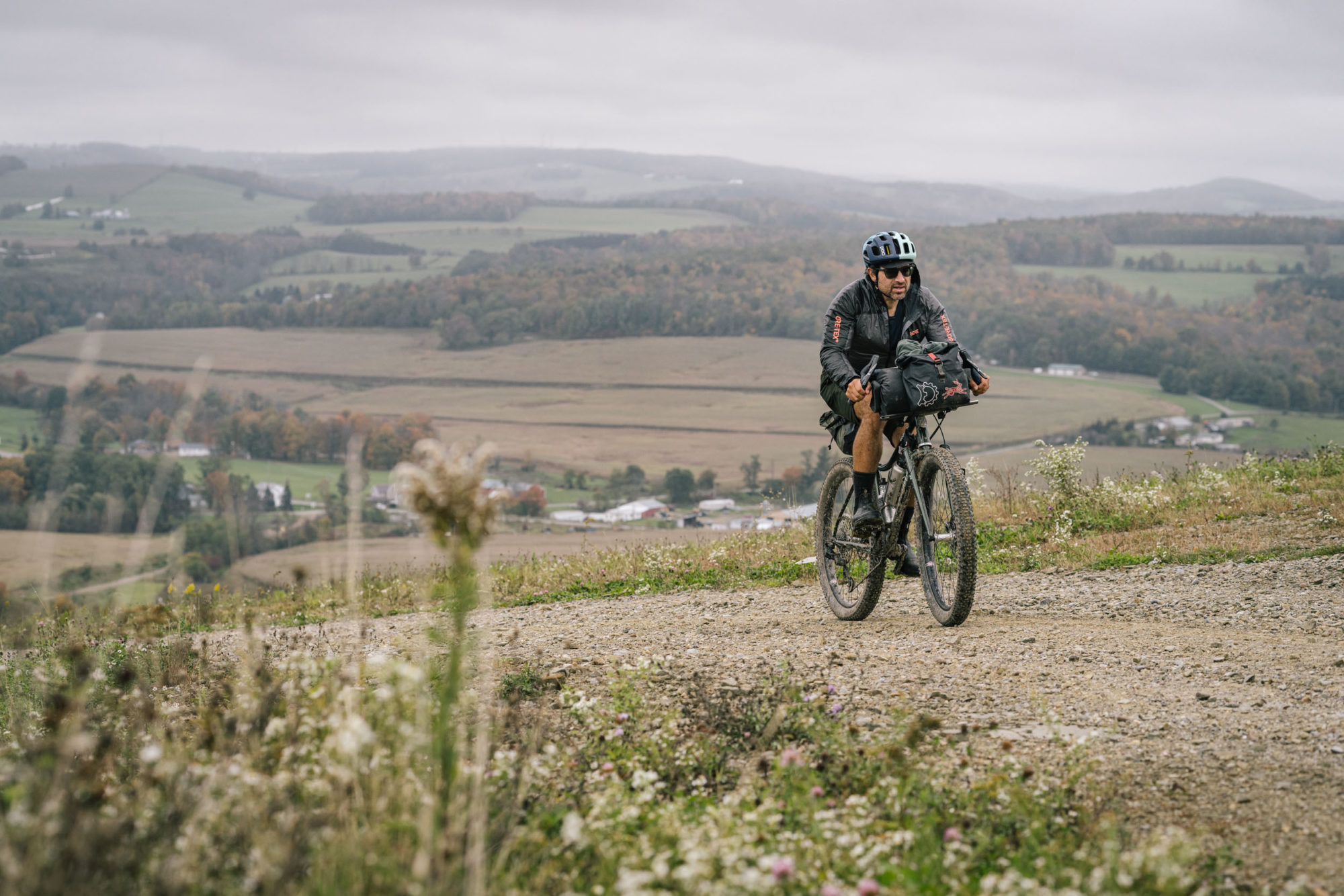
If you need a metaphor for the feel of the Moonshiner, think of it as a hard-to-stop rock crawler. The test bike was specced with 165mm cranks to ensure its capability in avoiding pedal strikes in the chunky environs it was conceived for. Combined with the aforementioned high bottom bracket, one feels oneself to be above trail impediments.
The bike is heavy—30.5lbs/13.8kg with a reasonably premium build on my scale—but it rides far lighter than one would expect. After a few outings of getting confident on it, I took the Moonshiner on my local blown-out, wrecked-by-ATV, rock-and-root labyrinth ride that is a very particular kind of mad fun. I’ve been riding that track for over three decades and I cleaned more of it than I ever have on any bike short of my 5” tire fat bike. The Moonshiner is finesse and tenacity.
GEOMETRY AND A HIGH, SHORT STEM
If a bicycle engineer from a century ago could have glimpsed bicycles in 2021, it’s easy to imagine that they would feel a sense of wonder but also vindication. Wonder because of the innovation in materials and the astounding technical refinements, but vindication in the fact that, very broadly speaking, they had basically figured out everything sensible with respect to the morphology of a bicycle. One thing that might pique their interest is our long stems. It is notable that, when you look at the first decades of the safety bicycles—i.e., the bicycles that by the late 1880s had succeeded the high wheeler and had two same or similar-sized wheels with the rear one driven by a chain—the stems are almost universally zero length. That is, the bars are affixed at the terminus of the steerer tube. When you concentrate on the drop-bar iterations of those bikes, coupled with their slack head and seat angles and long chainstays, there is an affinity between them and the Moonshiner.
What is the right stem length for a bicycle? Alas, stem length is a totally meaningless measure when considered out of the context of dozens of other decisions that went into the geometry and intention of the bike. An initial catalog of the synergistic factors that play a role in bike handling would include trail, head tube angle, seat tube angle, what tires you’ll run (because that determines pneumatic trail), bar width, seatpost setback, and bottom bracket height. To make things even nuttier, there’s the fact that—within a very wide latitude of bike-shaped machines—we’ll quickly adapt to any one we get on. Feeling right or feeling wrong is often a comparative judgment, with no factual grounding on whether the bike you were just on before this one is the proper benchmark for the present judgment.
You can therefore perhaps forgive the way the history of bicycle design is massively empirical in the sense of trying things out to see how they work, rather than making assured a priori proclamations based on numbers. I once asked a famous bike builder/engineer friend what he thought of low trail bikes and his answer was that he had no idea, that the only honest way to have an opinion would be for him to build a bunch of low trail bikes where 10 other things were changed or kept constant in every combination, and then to ride all of them in all kinds of conditions (he wasn’t the slightest bit interested in doing that, by the way).
Returning to stem length, researching this topic uncovers a labyrinth of folklore, data, dogma, and fashion. One thesis maintains that, on a drop-bar bike, a 100 or 110mm stem looks best. What this analysis lacks in rational basis is at least a bit offset by its honesty. Then there is the advice I grew up with, that the right stem length is where your bars obscure your front hub when you look down in a natural seated position. That reeks of a convenient bike shop heuristic that is maybe kinda in the neighborhood of right for a certain kind of bike, but that shouldn’t be confused for serious theorizing about handling.
Here’s an interesting passage from the 1982 edition of Bicycling Science that tries to reverse engineer the history of bicycle dimensions:
The standard diamond-frame safety bicycle has resulted in the universal selection of steering angles from a very small range. This range has emerged from the following considerations. The crank length has generally been chosen at 170mm to suit the majority of adult riders. The height of the bottom bracket has then been fixed so that the pedals clear the ground in at least low speed cornering. The rear wheel is brought as close to the bottom bracket as can reasonably be arranged, with the seat-tube angle positioning the saddle so that the rider’s center of gravity is reasonably forward of the rear-wheel center… In touring or commuting bicycles, the front wheel plus a possible fender or mudguard is brought as close to the bottom bracket as possible without there being a possibility of the feet or toe clips catching the fender or fender stays during a turn. If a large steering-head angle is used with this proviso [i.e., if the head angle is steep, —Ed.] the top tube… becomes long, requiring a long reach to the handlebars. Accordingly, a relatively small [i.e., slack, —Ed.] head angle is used for touring and commuting bicycles (p222).
Supposing that the above account is plausible, notice that there’s no fixed science on any of it. There is nothing intrinsic about what the bottom bracket height or seat or head tube angles should be. Geometry and therefore stem length are a series of verdicts made in relation to others, each of which makes some contribution to the feel of the bicycle.
This passage was removed from the third edition of Bicycling Science due, the authors report, to the collosal lack of scientific consensus on the choice for geometry measures. The revised section basically gives up and points out that human beings are highly suggestible to what they are told a bicycle will feel like, that “each observer is different,” and that no one knows what anyone else means by the terms they use to describe the feel of a bicycle (p301). The 2020 fourth edition of Bicycling Science says even less about the matter.
The stem length on your bike is likely the result of trying to achieve a nice-riding bike, assuming that some other things are true, like that you want to achieve an aerodynamic position, or that you’ll primarily ride on the hoods, or that you’re reasonably flexible in the lower back, etc. The Moonshiner advocates for its own list of priorities and invites you to consider whether the priorities you thought you had are really as non-negotiable as you think they are. It seems to me that the best we can do is to be clear on what decisions inform the Moonshiner.
James indicates that he relied on his experience as the head fitter earlier in his career at a busy shop specializing in high-end road bikes. After seeing many hundreds of riders come in to be fitted on the sophisticated Guru Fit System, he claims a solid grasp of which positions are efficient. As he explains it, that position is not far off of the classic era of road racing bikes, namely the 1960s and ‘70s ones before top athletes were selected for their flexibility in taking on the most exotic, stretched-out positions. James then increased the comfort of this position by keeping the relations between the contact point triangle but “rotating” it to move the front point—hands on the bars—upward.
Since the Moonshiner is designed to be ridden in the drop-bar hooks, the stem has to be pretty short in order for the rider to not be uncomfortably stretched out on a slack seat tube. Additionally, in order to not have to activate one’s core plus crane one’s neck the whole ride, the bars have to be pretty high, thus a high stack and high stem. Given that the biggest complaints about bike riding are lower back pain, neck soreness, and hand numbness, this configuration gives you a fighting chance of avoiding those.
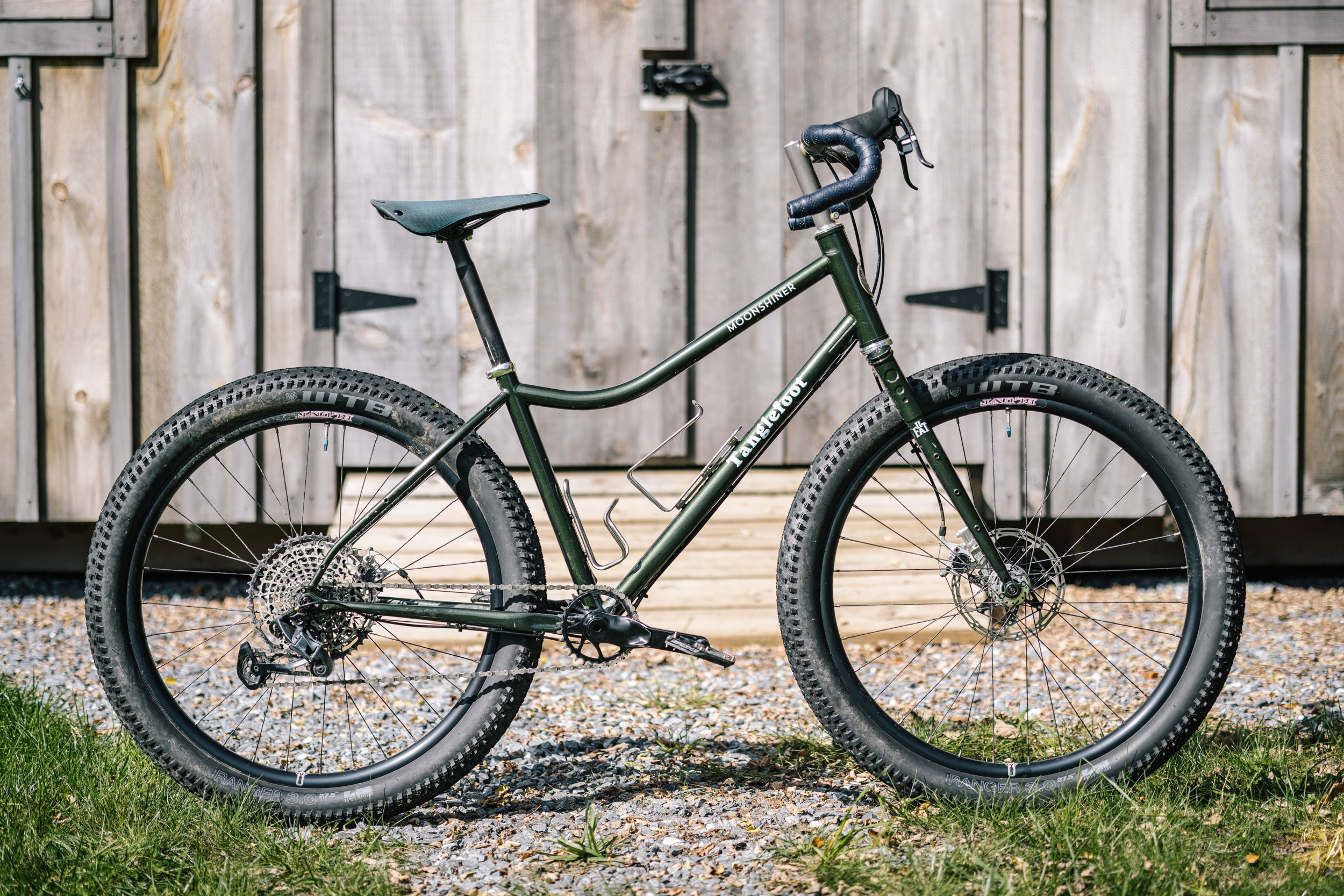
Add to the list of constraints at work here wanting to avoid toe overlap even with big winter boots with the foot centered on the pedal. Rather than lengthening the top tube, which would again stretch the rider, the head tube angle is slackened to push the front tire forward. Then a decision has to be made about the location of the final fixed point, namely the bottom bracket. James is persuaded that a high bottom bracket affords greater stability, and this lifts the entire triangle. That goes against claims that a low bottom bracket is more stable, but as always it’s hard to find science rather than anecdotes and impressions. In Just Ride, Grant Peterson says, “[bottom bracket] drop is the one area of bike geometry I feel fuzzy about… I’m suspicious of anybody who is as declarative about it as I used to be” (sect. 74). My anecdotal feeling, for what it’s worth, is that a high bottom bracket is preferable over a low bottom bracket, even at high speeds. And, as a bonus, a high bottom bracket yields better pedal clearance.
| Size | Small | Medium | Large |
|---|---|---|---|
| Stack | 615 | 635 | 660 |
| Reach | 375 | 420 | 450 |
| Effective TT length | 585 | 635 | 679 |
| ST length (C-T) | 424 | 464 | 524 |
| Head Angle | 69 | 69 | 69 |
| Fork Offset | 50 | 50 | 50 |
| BB drop | 51 | 51 | 51 |
| BB height | 318 | 318 | 318 |
| Seat tube angle | 71 | 71 | 71 |
| Chainstay length | 450 | 450 | 450 |
| Standover | 765 | 795 | 836 |
Finally, the top tube is bent to ensure massive dismount clearance in bouldery, broken terrain. The chainstay length reflects the need to fit a plus tire behind the 73mm bottom bracket and enhance stability further with a plausibly long overall wheelbase.
Voila! The Moonshiner.
DROP BARS
Speaking of familiar narratives, there is another one around drop bars claiming that their multiple hand positions are desirable from the perspective of soreness or fatigue. I’ve never been much moved by this argument, and have done my biggest trips always on riser-bar bikes. On the flip side, I spend a lot of time riding drop-bar gravel bikes. My view about that is, I assume, probably pretty common: the majority of the time I’m on the hoods, I ride on the tops sometimes to achieve a bit of back change, especially while climbing or at low speeds to look around in town, and the hooks are for when things get serious in a paceline or when descending or when I’m simply in a mood to haul ass. That’s all pretty different from the Tanglefoot drop-bar situation. On the Moonshiner, I’d say I spent upward of 98% of my time in the hooks. I’ve certainly gone entire three or five-hour woods rides never on the hoods or on the tops.

I’m not sure that multiple hand positions is the right argument for putting drop bars on the Moonshiner because the hoods and the tops are so high up they just don’t seem that usable to me. Occasionally I might ride the tops to be outlandishly upright and look around and take some photos, but I’d quickly go back to the far more comfortable hooks. The in-the-hooks position is completely happy and sustainable for hours, days, and weeks at a time. On the Moonshiner hooks, my hands are somewhat higher than where my hands are on the hoods of my gravel bikes, and much higher than when my hands are in the gravel bike hooks. My gravel bike position, I suppose, substantially trades comfort for aerodynamic efficiency.

Then again, the Moonshiner hand position is within a centimeters both up-down and fore-aft of where my hands are on the grips of my flat-bar bar expedition bikes. The location in space is basically the same, but the grip and therefore arm position is different. I feel like I generate consistent power on the Moonshiner, but I also do so with my hands on the grips of my riser-bar bikes. Is there any reason to prefer hooks in the mountain biking/rugged bikepacking context as the Moonshiner proposes?
This is where things get murky for me. I absolutely found the cockpit of the Moonshiner easy and comfortable for long days in the saddle and on broken, technical terrain. I felt planted and ready for what the trail might throw at me, I could react to bike input and turns and snap back to center as well as I could on any of my personal bikes. If you like riding in the hooks on dirt drops, then I suspect you will be thrilled with where the Moonshiner places the bars. In another sense, however, I found that it required adaptation, and I’m not sure whether after two months I got to the level that I am at on my riser-bar bikes. That sense has to do with pulling up over obstacles with control and strength, and that ability to throw the bike around where there is a lot of wheelieing the front wheel. I’m a few percent better mountain biker when I’m on riser bars than I am on drop bars with my hands at the same height and comparable width. Surely the bulk of the explanation is the uninteresting fact that I’ve mountain biked on flat/riser-bar bikes for most of my life.
This much is clear to me. Drop bars are undoubtedly supremely functional and comfortable. Riding off-road in the drops is different from on a riser-bar bike, but not essentially worse (or, I’d say, better). Again, if you think of yourself as on the drop-bar side of things, the Moonshiner will likely fill you with happiness.
BIKEPACKING ON THE MOONSHINER
I took the Moonshiner out on a five-day trip in Western New York and loaded it with a front roll and a seat bag with my typical late summer gear. I also took it out on numerous day trips with a load just to test it out. As a bikepacking platform, it exhibited spectacularly good manners, and my view is that it’s terrific for that purpose. A load on the bars slowed down the steering just as one would expect, but the bike remained shockingly maneuverable and agile. I wouldn’t hesitate to take it on the longest, most faraway trips. Sturdiness is one of the themes that should be emerging from this review; for bikepacking you can load the Moonshiner however you like.
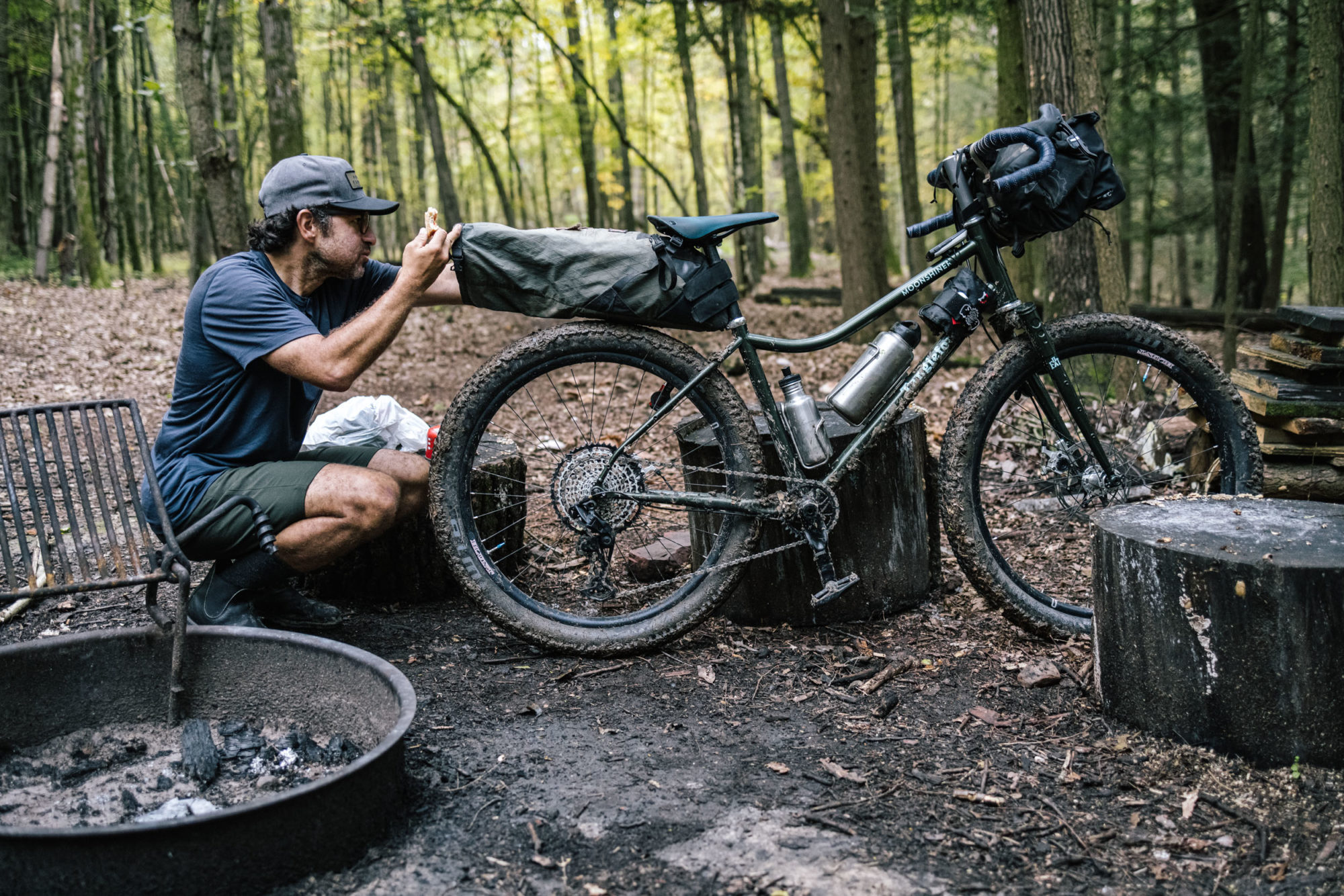
As built, the front end of the bike is the most bikepacking-friendly arrangement that I can think of for two reasons. The first is that there is a massive amount of space for a large handlebar roll or bag, even for a small rider. One of the persistent limitations of bikepacking with a front roll is the distance between the bar and the top of the front tire. For small riders, this typically means going with a very low diameter front roll which, when compressed between the drops, doesn’t actually fit that much. The Moonshiner completely overturns that limitation. I used my highest diameter Revelate front roll and the bottom of it is miles away from making contact with the tire. It’s easy to imagine strapping an additional tube-shaped bag, like a tent, under the front roll.
The second advantage is that on such a short length stem, the bag isn’t cinched and tucked under the bar, per se. Instead, it rests on the stem, which generally makes it more stable. As long as I had three very tightly cinched attachment straps—two on the bar tops and one on the stem itself—the bag did not wiggle, even with a large pocket out front.
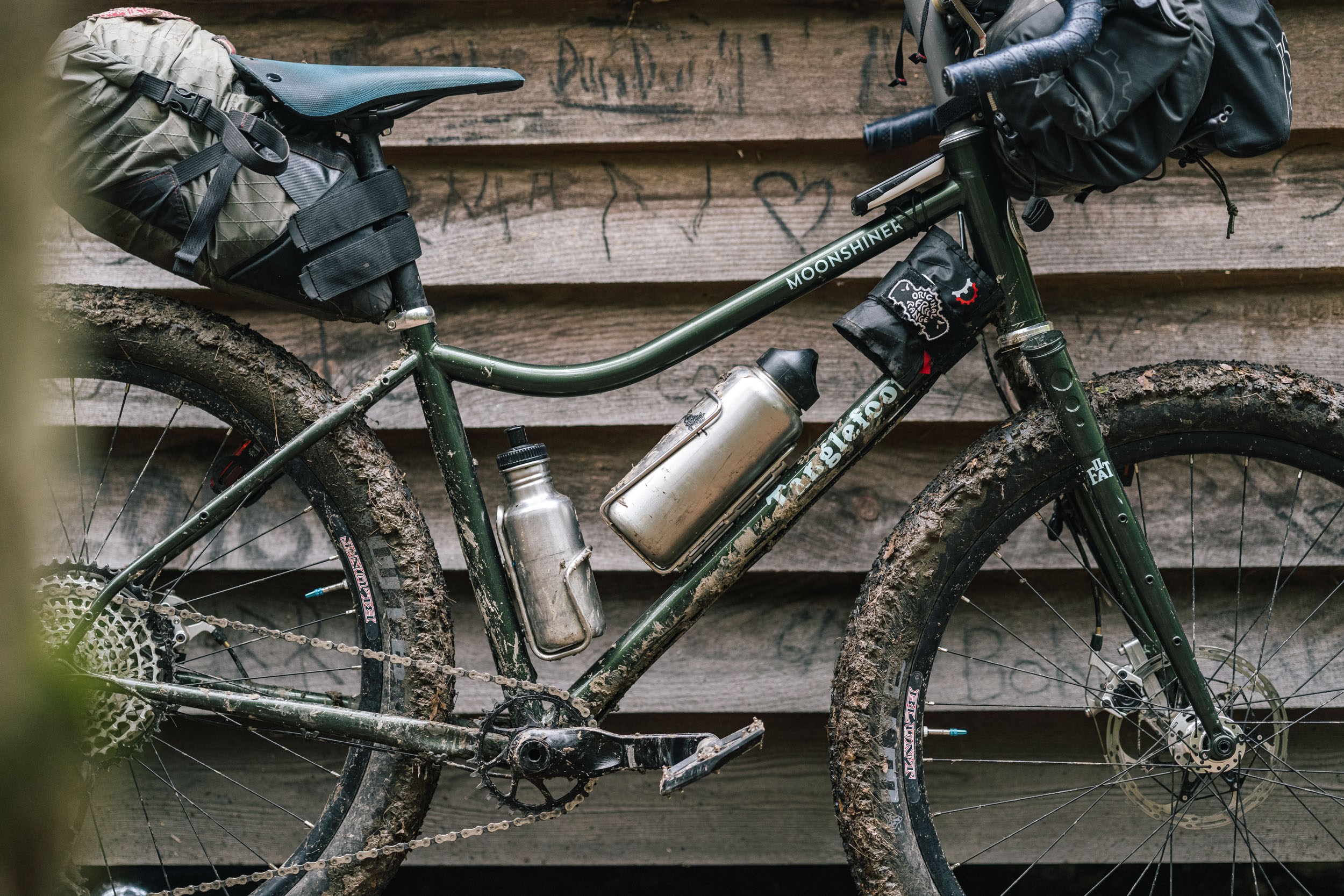
One thing to think about is the oddly shaped main triangle. This wasn’t an issue for me as I was each time rolling with my standard compact camping setup, so I pedaled with one standard and one oversized bottle cage in the triangle instead of a frame bag. If you’re used to a generous frame bag, you might have to adapt. Tanglefoot is working with a USA bag maker to sew bags specifically for the Moonshiner frame (and of course you could get a custom one), but the bent top tube will likely yield a bag somewhat smaller than it would be with a standard triangle. There are no provisions for a bolt-on top tube bag.
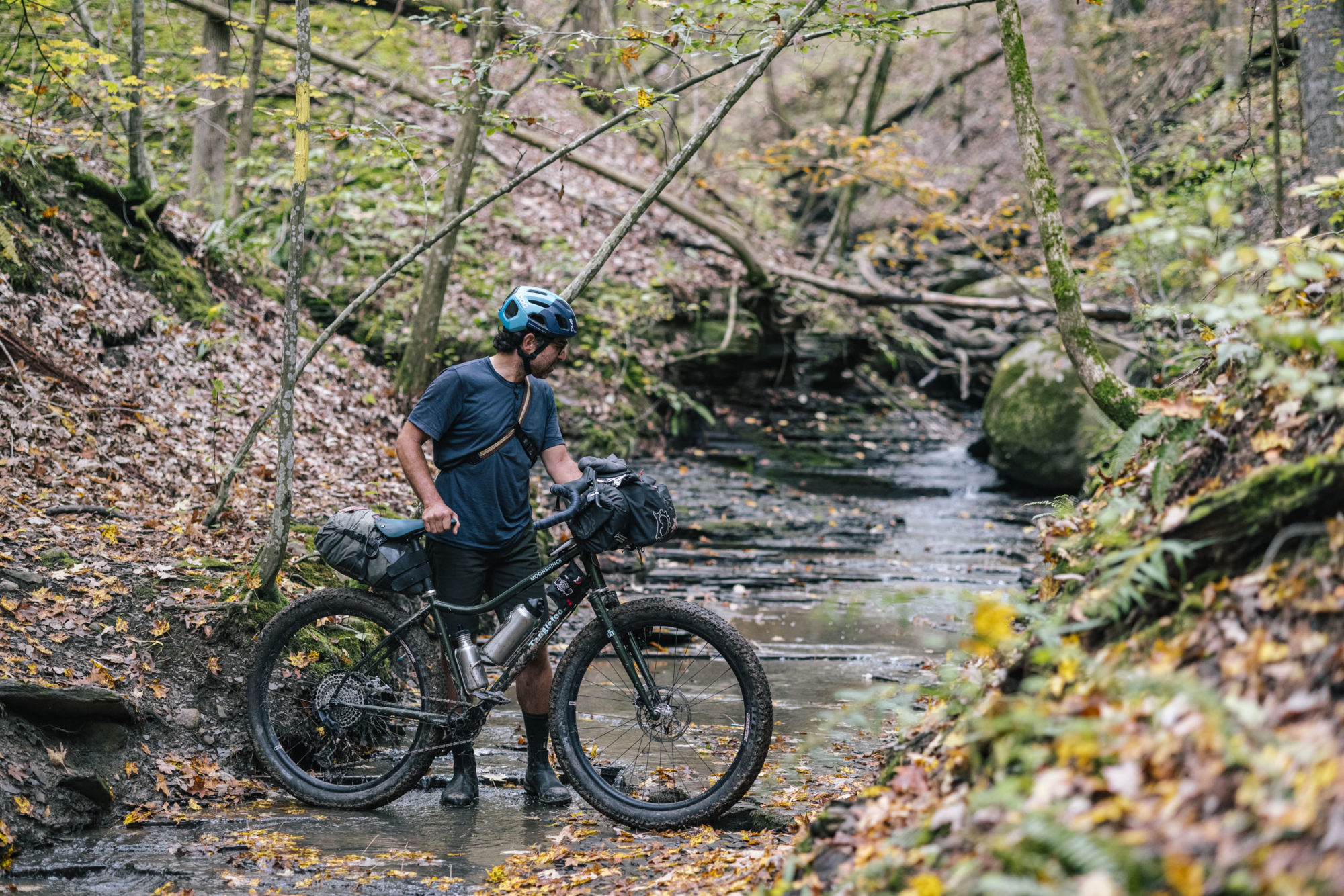
WHY MIGHT YOU NOT WANT THIS BICYCLE
Honestly, for the kind of riding I do, I don’t have anything that I really think of as a reservation about this bike. I absolutely wanted to keep it, but my bicycle situation these days is, alas, ((N+1)-2).
Tanglefoot presents their Moonshiner as the ideal tool for East Coast (USA) gnarly riding, and that fits with my impression of it. Might that make it too niche, however? What about people who ride under big skies out in the Western USA or Australia, pass hunt in Japan, or ride military roads in the Alps? My feeling is that much about the Moonshiner that makes it sparkle in Vermont will also make it uber-capable virtually wherever you ride: Accurate steering, forgiving, comfortable, resilient, and up for crawling over obstacles all day. To me, the question isn’t whether the Moonshiner is too niche, it’s whether the standard bikes that are sold to people these days are versatile enough to achieve ATB riding in its best form.
I think I can identify some questions, though, that might give you insight into whether the Moonshiner is right for you. Consider the following four. If your answer to any of them is a very committed “yes,” then I think there’s a chance that the Moonshiner isn’t ideal.
—Is it a complete non-starter for me to ride in the drops something like 95% of the time (assuming that my back is completely comfortable and I am upright enough to not strain my neck)?
Riding in the drops as the primary control interface is a big part of what’s going on in the conception of the Moonshiner. If you’re pretty sure that that’s not what you’re after, then there’s one fewer reason to consider this bike. Notice, though, that, if your riding experience is pretty typical, it’s unlikely that you’ve spent much time on a bike with drop bars so high and so close. So, your confidence about this matter may be misplaced. Moreover, it’s absolutely possible to build up a Moonshiner with alt or riser bars and a stem of the proper length for the bars. I presume that you’d still get the preternaturally excellent handling, but I have no data on that.
—Am I thinking of often racing my bike on short-ish (sub-five-hour) mountain bike courses or in gravel events?
The Moonshiner probably wouldn’t be a particularly competitive tool in a standard mountain bike or gravel race. In an XC mountain bike race, comparably skilled riders on lightweight bikes with suspension will leave you behind. In a gravel race, the aero position and more efficient tires of modern gravel bikes will be hard to compete with. Then again, on a demented 12-hour woodsy scramble with varied terrain and plenty of chunk, this might be as good a tool as any because of its all-day comfort and remarkable sure-footedness.
—Is going fast on dirt roads, rotating through a paceline, dropping some folks on a climb, one of the main reasons I join group rides (kind of like racing even if it’s not actually racing)?
That’s not what this bike is for. How did you get this far in this review and think that it might be? And it should go without saying, the Moonshiner does not miraculously transmogrify into a fast bike on the pavement. You’re not going to be telling a story about that time you “accidentally” found yourself with a group of shaved-leg roadies and you were easily able to keep up, much to their dismay. Stop wanting to tell that story, it’s silly. Again, the drop bars are not there for an aero position but instead to achieve a specific kind of control and comfort while in the hooks.
—Is a lightweight bike in and of itself an important goal for me?
The Moonshiner is not a light bike, as it’s trying to maximize other priorities.
FRAME NOTES
The Moonshiner is welded in Taiwan to Tanglefoot’s exact and exacting specifications, and James is proud of his relationship with the Taiwanese craftspeople who make it. James reports that he pursued building it in the USA, but the tube bends and manufacturing specs were complicated enough to make that prohibitive and he just couldn’t make it happen.
At US$975 for the frameset, the Moonshiner isn’t a budget proposition but it’s not crazy, either. The details and the finish certainly say something about how much care went into its creation. On the medium and large, there are triplet water bottle bosses inside the seat tube and downtube, while the seat tube on the small has only double braze-ons to avoid dropper post interference. In addition to rear rack and fender mounts, there are mid seat-stay mounts for a bag support attachment like at Nitto R10. All the cable routing is external for an easy build, and the reinforced seat tube entry for a dropper post cable is beautifully executed. There’s a small reinforcement ring at the bottom of the seat tube clamp slot so that a crack can’t form there. There is a downtube gusset and a handsome headtube badge. It’s all very, very nice.
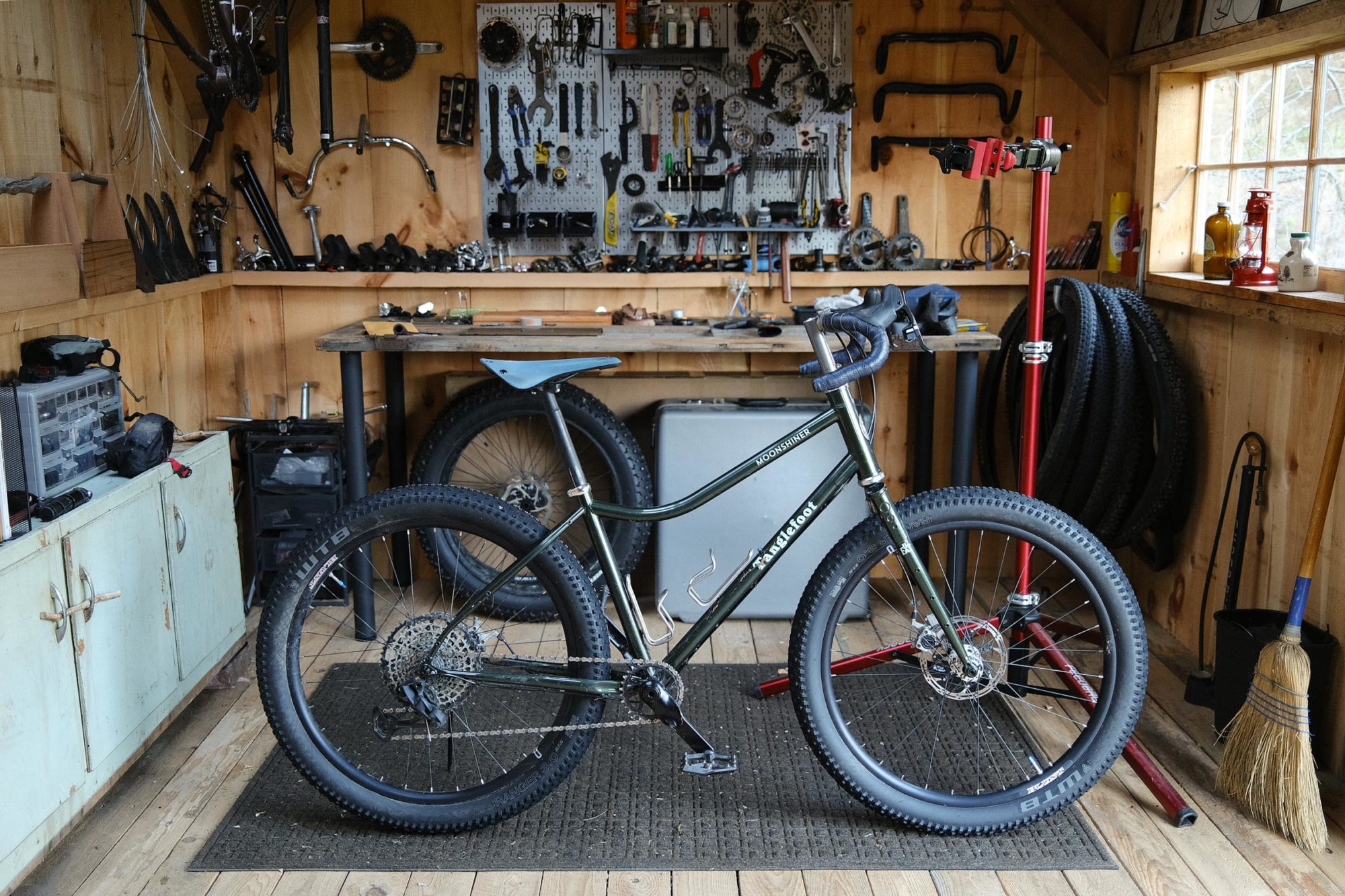
Special mention should be made of the Dr. Seuss looking fork, reminiscent of forks that Waltworks and others were building during the early fat bike days. The Moonshiner’s has a gorgeous cast crown with cutouts and the Tanglefoot logo stamped at the top of the blades. There are three water bottle bosses on each fork blade and, of course, rack and fender mounts. The fork is properly described as burly and it would be quite hard to break it. You’d also be hard pressed to find a heavier fork.
The Moonshiner is made to still be in your shed in 15 or 30 years and working great (like my ‘89 Wicked Fat Chance). You may have put racks and fenders on it and use it solely to go to the market. Or maybe your teenager rides it. Or maybe it’s the last bike you bought because you were disgusted by the five-year bicycle replacement cycle that results from fashion or planned obsolescence.
Superficially, the Moonshiner is reminiscent of a Fargo, but in actual practice it’s a distance away since the Fargo has a significantly steeper seat tube and shorter reach, which leads to a 70-80mm stem and toe overlap. Bikes like the very attractive Black Mountain La Cabra also share a family resemblance to the Moonshiner, but the La Cabra has a 20mm lower bottom bracket, a steeper seat tube, and lower trail. I think a better comparison is to a Jones. I’ve never ridden one, but Cass—who I trust in spite of his Flashdance-style alpaca leg warmers—is a big fan. The Jones has a comparable seat and head tube angle and achieves the right fit by the Jones alt bars that extend back toward the rider from the stem. It’s a different route to a close-by destination, though, of course, your hands will be in a different position on the alt bar grips than deep in the hooks of a drop bar. The Jones does have a much lower bottom bracket.
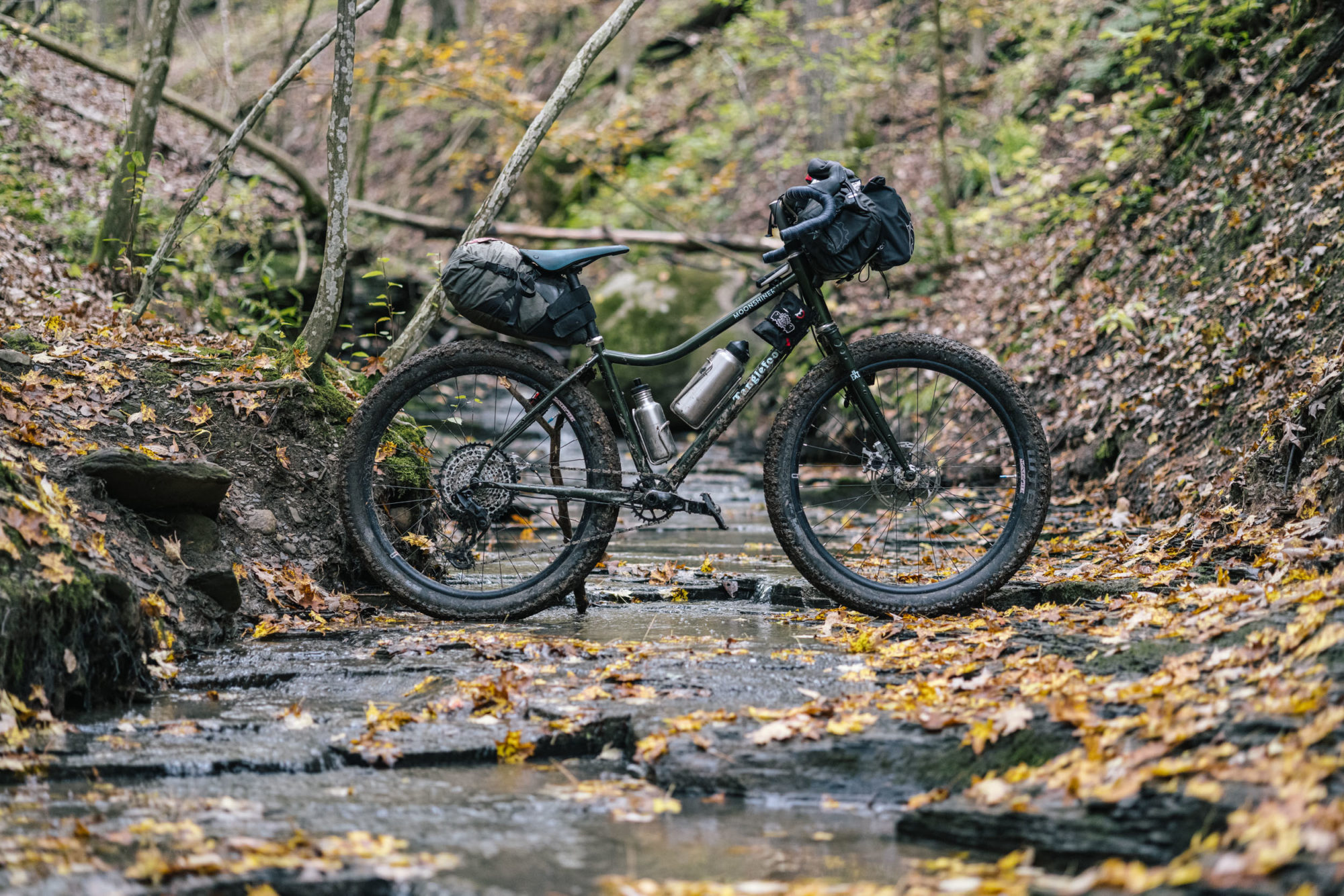
Build Kit
You could purchase the Moonshiner frameset and build it up yourself, but if you work with Analog or one of Tanglefoot’s dealers, you’ll have expert advice and guidance on your build. Candice is the lead bike builder and mechanic at Analog, and her taste is impeccable. She has deep knowledge of functional parts combinations and an eye for catchy colors. A visit to Analog—which is in an off-the-grid sugaring house in Poultney, Vermont— is a treat in itself. It’s one of the coolest bike shops I’ve ever been to and reminiscent of some very curated Japanese shops. There’s so much good riding thereabouts that it would be easy to make a day of it.
The components that Analog Cycles provided for the test bike were a mix of fairly premium and more middle-of-the-road, with an estimated complete cost of US$4,500.
- FRAME Tanglefoot Moonshiner (steel)
- FORK Tanglefoot II Fat (steel)
- HEADSET White Industries
- BOTTOM BRACKET Wheels Mfg.
- CRANKSET Ignite Catalyst
- CHAINRING Garbaruk 30T
- CHAIN SRAM GX Eagle
- CASSETTE Garbaruk 12spd 10-52
- SHIFTER/BRAKES SRAM Force *Ratio 12sp Upgrade Kit
- DERAILLEUR SRAM GX Eagle
- BRAKES Paul Klampers
- RIMS Velocity Blunt 35mm
- FRONT HUB Bitex
- REAR HUB Bitex
- TIRES WTB Ranger 27.5 x 3.0”
- STEM Discord Chromo Peeper 30mm
- HANDLEBAR Ritchey Comp Beacon
- SEATPOST NItto S92
- SADDLE Brooks Cambium C17
- PEDALS Spank Oozy 2.0
It took some getting used to the SRAM Force levers in a full-on mountain biking context. They worked perfectly, but the materials, from a tactile perspective, seemed not quite right as they flexed and felt plasticky. The shifting of the GX Eagle derailleur on the Garbaruk cassette was flawless, and I appreciated the big sweeping gear changes that came in handy on up-and-down terrain. The Paul Klampers cable disc brakes are a favorite around here and proved themselves again.
This was my first time riding Ritchey Comp Beacon bars, and I got along very well with the shallow drop, short reach, and ergo bend in the drop. The 36 degree flare was excellent.
The CNC machining on the USA-made Ignite crankset was impressive and looks great. To me, they have an H.R. Giger vibe. They were also functionally flawless. There is not a whisper of flex in them and I’ll myself go straight to Ignite the next time I’m in the market for crank arms and a spindle.
Candice reports that complete Moonshiner builds begin at about US$3,800 “with no garbage parts,” and recent builds have been coming in at US$5,000-5,500.
- Model/Size Tested: Small
- Actual Weight: 30.5 lbs/13.8kg (with pedals)
- Place of Manufacture: Taiwan
- Price: US$4,500 (Analog’s estimate)
- Manufacturer’s Details: tanglefootcycles.com
Pros
- Supremely capable all-terrain bicycle, one of the best riding bikes I’ve ever been on
- Incredibly comfortable
- Versatile attachments for any kind of riding
- Excellent for bikepacking with lots of room for a front roll or bag
- Refined details
Cons
- Heavy, especially the fork (but it rides far lighter than the number on the scale would suggest)
- Divisive looks?
Wrap Up
Looking at the Moonshiner, all kinds of thoughts might visit your mind with a more-than-usual dependence on your aesthetic taste. It can seem like the excitement of possibility or too “out there.” The thing is, people try to turn their visceral reaction into a reasoned critique of a bicycle never having ridden it, and the ensuing abject nonsense would be hilarious if others on a Reddit thread didn’t take it seriously.
Put aside your assumptions and your on-paper analysis of what this bike should ride like. It can take a rider deep into rugged terrain. Unloaded or on a long trip, it is agile, unflappable, as good a descender as any rigid bike out there, and almost impossibly fun to ride. It’s comfortable riding in the drops with no toe overlap, gobs of pedal clearance, and excellent manners in the most demanding conditions one is likely to be able to ride a bicycle. That is its mandate, and it succeeds mightily.
Please keep the conversation civil, constructive, and inclusive, or your comment will be removed.






